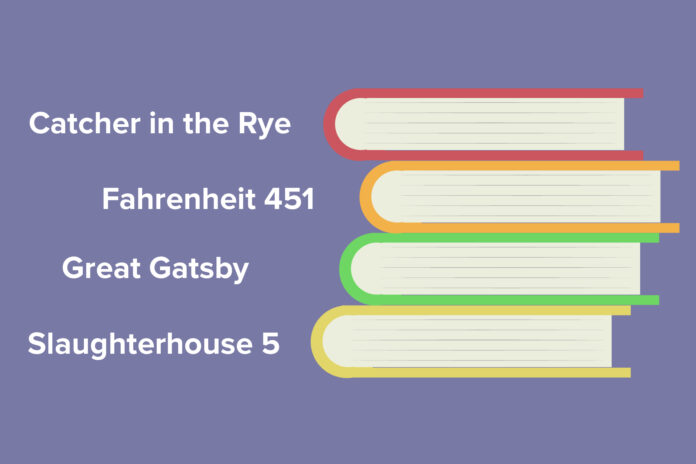Books of the past compared to college reading
Looking back at books from our past, the novels that stand out are ones that were taught in high school classrooms, were trending with our peers, or were part of a larger phenomenon. College opens up a world of knowledge and education for many to explore their own literary preferences. This list serves as a short revisitation to books of the past in comparison with potential books that many have read in college.
Freshman Year
While many have strong opinions about the “Twilight” series, it was nevertheless a large part of everyone’s adolescence. Stephanie Meyer’s novels provided a fantasy world where love existed in the form of a sensitive vampire and a rugged werewolf. Memes aside, this series played a pivotal role in conversation and daily life for a freshman in high school trying to find love with the sparkling boy in their chemistry class. Sharing the theme of “light,” Virginia Woolf’s “To the Lighthouse” is a novel comparable to “Twilight” in the sense that they have nothing in common. The same way that freshman year of college was extremely transformative, the philosophical exploration of reality, work, intellect, and the passing of time in “To the Lighthouse” seemed to perfectly relate to themes present in freshman year of college.
Sophomore Year
During sophomore year of high school many students read J.D. Salinger’s “Catcher In the Rye” and remember a red hat and that everyone’s a “phony.” This book polarized many people because they themselves were attempting to learn who they were and how they interacted with those around them. It put words to feelings they didn’t know how to express yet. For those who viewed life a little more optimistically, Holden’s disconnect from reality was sad and frustrating to read. This book will forever remain a staple in American literature. Joseph Heller’s “Catch-22” is another book with a cult following that might have been read around the same time, but seems to be more applicable to the college sophomore year experience. This book is longer and heavier than “Catcher in the Rye,” but where “Catcher in the Rye” left people saying everyone’s a “phony,” “Catch-22” left people saying “you’ve got flies in your eyes”. This post-World War II satire functions as a comical look into the absurdity of war, bureaucracy and American life. And for many, sophomore year of college is a time where they begin to question their major, the bureaucracy of the UC system and the American college experience. These books are completely different, but in considering their long lasting impacts and ability to appeal to a group of people who feel disheartened or lost, they both function similarly.
Junior Year
The junior year of high school curriculum seemed to differ depending on the English class, but “One Flew Over the Cuckoo’s Nest” by Ken Kesey, a popular choice, features the changing approaches to psychology and psychiatric institutions in the late 1950s. This novel is filled with allegory, symbolism and mature content that most students enjoyed because it was different from anything they had read before. This book felt like one of the first times in high school when students were trusted with heavier content, and with the context of further education, it serves as a great reread. Choosing a book that rhymes with “One Flew Over the Cuckoo’s Nest,” it seems that “Infinite Jest” would be fitting for junior year of college. David Foster Wallace’s famous 1,079 page novel is a complicated work that many have attempted to read and understand, and many have achieved. Or so it seems at least. It’s a novel that seems to fit the rigor and challenge of junior year of college. As a “postmodern encyclopedic novel,” this categorization seems to describe the academic rigor of junior year in which there probably was not enough time to fully commit to understanding the book, but at the very least, students felt accomplished knowing they finished it. If this seems daunting, I would recommend rereading “One Flew over the Cuckoo’s Nest” instead.
Senior Year
Senior year of high school was an introduction to existentialism and the theatre of the absurd, which has not so ironically seemed to remain a theme throughout college, especially senior year as many are faced with things that won’t be listed here as not to trigger any further existential crises. Samuel Beckett’s “Waiting For Godot” is a play that many read and enjoyed their senior year of high school. As two characters wait for Godot to arrive, they contemplate death, God and their life. The absurdity of this play seemed to excite everyone who read it, and those that didn’t enjoy it at least got a kick of their teacher asking people to read scenes. A novel with similar themes of existential dread, which has probably not been revisited by many since their parents gave it to them in middle school, is Judy Bloom’s “Are You There God? It’s Me, Margaret.” While this book mostly deals with a sixth-grader coming to understand herself and the world around her, there is no time like the imminent dread of entering the real world to reconnect with simpler times while reminding yourself that even at a young age, you still had to deal with life’s looming questions.
Written By: Rosie Schwarz — arts@theaggie.org





